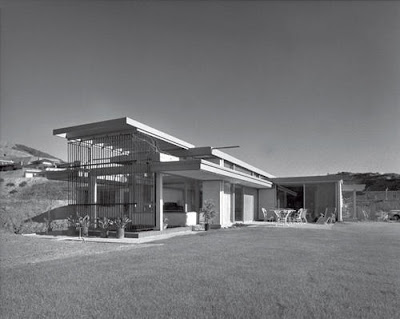 Julius Shulman at his home, 2005 © Laura Wilson
Julius Shulman at his home, 2005 © Laura WilsonA sad week indeed for photography. Firstly Dash Snow’s untimely demise and then the passing of a true legend - architectural photographer Julius Shulman has died at the age of 98 at his home in Los Angeles.
Shulman’s vision and impact on phtography are hard to overstate. Along with fellow photographer Ezra Stoller, he basically wrote the book on what constituted modern (and Modernist) architectural photography, and his images are still the benchmark for photographers working today. Beyond the vision apparent in his photographs, Shulman also helped people to understand and appreciate modern architecture itself – promoting this new ideal, and, through the pages of architectural magazines and journals, showing it to the wider world.
Born in Brooklyn in 1910, Shulman studied photography only briefly at his high school, and although he sometimes took photos whilst a student at Berkeley to earn some money, it was only through a chance meeting with architect Richard Neutra in 1936 that he really started on his career path. Shulman’s sister happened to rent a room to one of Neutra’s draftsmen, who invited him along one day to see the construction of the Kun House in Los Angeles. And fortuitously, Shulman took his camera along. "I had never seen a modern house before," Shulman said. It "intrigued me with its strange forms -- beyond any previous identity of a house in my experience." He developed a few of the pictures he shot and gave them to the draftsman, who in turn showed them to Neutra. The architect was impressed with what he saw, and invited Shulman to photograph some more of his projects, and thus began his career as an architectural photographer.
Through Neutra, Shulman met other prominent architects of the time who were pushing the boundaries of architecture and defining the Modernist movement, and over the following decades he photographed the key work of nearly every pioneering architect - Rudolf M. Schindler, Frank Lloyd Wright, Charles Eames, Raphael S. Soriano, John Lautner, Eero Saarinen and Pierre Koenig to name a few. It was his shot of Koenig’s stunning glass-walled Case Study House No. 22 overlooking Los Angeles at night, taken in 1960, which would really cement his reputation. Featuring two women casually chatting with a jaw-dropping backdrop of Los Angeles at night spread out beneath them, it perfectly encapsulated the aspirational, sleek, idealized modern Hollywood dream of that era, and is one of the 20th Century’s most iconic images. As architecture critic Paul Goldberger wrote in the New York Times, " [it is] one of those singular images that sum up an entire city at a moment in time."
It wasn't only forward-looking and fabulous buildings that caught Shulman's eye though. He loved the city of Los Angeles and all it's strange traits and quirks, and documented it thoroughly. Some of his lesser-known images such as The Last Remaining Houses on Bunker Hill and Angel's Flight show a more tender and wistful side to his vision, whilst still showcasing his compositional and tonal mastery.
In my role as Photography Editor at Wallpaper* magazine I was lucky enough to work with Shulman twice, commissioning him to shoot two different Modernist houses in LA . He was charming and wry in person, and almost effortlessly and instinctively knew where the best angles and shots lay, and at what time of day he should shoot them. He was so comfortable with shooting that he gave up using a light meter in the 1940s and trusted his instincts from then on! There was also a boundless enthusiasm he had when shooting - not always a common trait in someone who has been photographing variations on the same theme for 70 years.
In 1995 The Getty Center in LA acquired Shulman’s archive, containing more than quarter of a million negatives, prints and transparencies – an amazing collection; an almost definitive photographic record of the architectural adventures of the United States during one of its most exciting periods, which I doubt will be surpassed. Unintentionally, this archive now also now serves as a record of the Golden Age of Modernist architecture, capturing some of these architects’ finest work for all time, since many of the buildings have sadly been pulled down or unsympathetically remodeled and ruined.

Shulman's most iconic picture, Pierre Koenig's Case Study House #22, 1960
Shulman at work photographing Case Study House #22, 1960
A colour image from the same shoot, 1960
The Steeves Residence, 1960
The Spencer Residence, 1950
The Kaufman Residence, 1947
The Bass Residence, 1958
The Arango Residence, Acapulco Interior of a house by William Alexander, 1952
Interior of a house by William Alexander, 1952
The Chuey Residence, 1958
Case Study House #21, 1958
Angels Flight, Los Angeles, 1969
 The Saltbox and the Castle, the Last Remaining Houses on Bunker Hill, 1967
The Saltbox and the Castle, the Last Remaining Houses on Bunker Hill, 1967  A young Shulman at work, date unknown
A young Shulman at work, date unknown All image © Julius Shulman Photography Archive, Research Library at the Getty Research








































+2007.jpg)





2008.jpg)

















